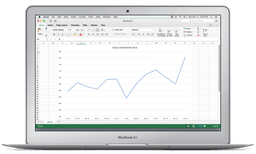
Marketing Best Practices
8 Key Real Estate Marketing Metrics You Should be Tracking
Digital marketing is increasingly becoming one of the key drivers of success for any commercial real estate sales or lease up effort.
Whether you’re a building owner or a CRE broker, keeping track of your marketing activities is crucial and will help you determine where to allocate your marketing budget and what isn’t working so it can be improved.
Once you launch your listing or commercial real estate website, then tracking results is easy and the math is straightforward:
More visits = more leads
More leads = more sales
More sales = more commissions.
So how do you start to create a marketing report?
With the abundance of existing information about marketing metrics we’ve narrowed it down to the 8 real estate marketing metrics that are most relevant to your real estate funnel and to the end result: closed transactions.
We’ve also included a marketing report sample spreadsheet you can use for your own property marketing. Simply download and swap your data to instantly generate results and graphs.
8 Key Real Estate Marketing Metrics
Measure these 8 metrics to track the success of your real marketing performance and help build a marketing report.
1. Total Visits
Visitors to your site is the most direct way to measure interest and whether you are generating enough visibility. This is an important number to measure that has direct impact on the rest of the funnel.
Look at total visitors (volume) for a given time period and month-over-month trend (growth).
Dig in further and look at this data by marketing channel. For example, how much of your volume and growth is attributed to Google? Loopnet? Email blasts? Social media?
2. Total Leads
Leads are any prospects that contact you via your website. This could be by clicking an email link, filling a contact form, or picking up the phone to call you (more difficult to measure).
Similar to visitors, your real estate lead reporting should measure total number of leads and month-over-month trend. Ideally, you should also break this down by marketing channel to understand where you should be spending more of your efforts for greatest impact.
If your website is not producing leads, then it’s not having much direct impact.
3. Total Sales
Sales is the end game. It’s not only the result of attracting visitors and generating leads, but also your ability to close the deal.
The key to understanding the impact of your real estate marketing efforts is your ability to measure what sales were achieved from leads generated by your online activity.
Why?
Because this will give you a holistic view of your entire marketing and sales efforts. It bridges the gap of online efforts with offline deals. Look at total deals closed (volume) and revenue generated (deal value).
4. Lead Conversion Rate
Once you have visitors and leads, then you can calculate your lead conversion rate. The formula is simple:
Leads / Visitors = Lead conversion rate
For example, if you had 2 leads and 100 visitors for a given month. Then you would have a 2% conversion rate.
This is an important metric because it gives the relative impact of your results which can be obscured if you only look at absolute numbers. Moreover, it becomes very useful when comparing month-over-month trends to give an accurate picture of progress.
5. Sales Conversion Rate
Besides total volume, it’s also important to measure your sales conversion rate. This will help you answer a very critical question:
How many leads do I need to generate 1 sale?
The calculations is as follows:
Total Sales / Total Leads = Sales Conversion Rate
This is very challenging because the sales cycles in real estate are long and it requires extremely detailed tracking. Fortunately, there are number of tools and CRM systems that can help you with that.
6. Total Marketing Costs
Look at all of your costs for marketing spend and break it down for a given period of time. This can include costs related to advertising, PR, email marketing, website updates, consultants, agency fees and anything else related to your marketing efforts.
If you have a dedicated marketing team, then headcount costs should also be included.
Measuring overall marketing spend gives you the ability to track the relative efficiency and impact of your marketing as it relates to cost per lead and overall return on investment.
7. Cost Per Lead
Now you can get an idea of what is your cost per lead (CPL), or how much money do you need to spend to acquire 1 lead?
For any given period of time, the calculation is:
Marketing Costs / Total leads = Cost per lead (CPL)
With this metric, you will get a sense of the overall math for your real estate marketing activity. It should help you understand “If I spend ___ on marketing then I should expect ___ in leads” and how viable it is to scale your efforts.
If you’re marketing investment is not translating into leads, then you need to know assess if there are other marketing activities that could be more effective.
8. Marketing ROI
If you’re tracking your marketing expenditure and the closed deals from your online activity you can easily determine the quantitative impact and overall real estate marketing ROI for your entire marketing/sales funnel.
Total Sales Value / Marketing Costs = ROI
Once you have this framework in place, you can drill down deeper to look at channel performance and specific marketing activities to help you answer the following question:
What gives me the best real estate marketing ROI?
If you can’t answer this question, then it will be difficult for you to understand the basic unit economics needed to grow and scale your business.
Marketing Report Template (Excel)
To help you put these KPIs into action, we’ve created a sample real estate marketing report that encompasses all the key metrics outlined above in a comprehensive Excel file you can download. Simply open the template file, include your own data in the spreadsheet and then refresh to automatically visualize everything in pivot graphs.
Further reading:
Related Blog Posts
CRE Technology
5 Reasons Why Salesforce Needs a CRE Marketing Platform
Salesforce isn’t only the most widely used CRM, it’s also the leading choice in the...
Company updates
Streamline Your Outreach with Tag-Based Email Campaigns
We are thrilled to announce the launch of our new Tag-Based Email Campaign feature, designed...
Company updates
SharpLaunch Announces New Integration with LandSearch
We’re excited to announce a groundbreaking integration with LandSearch, a prominent online...




